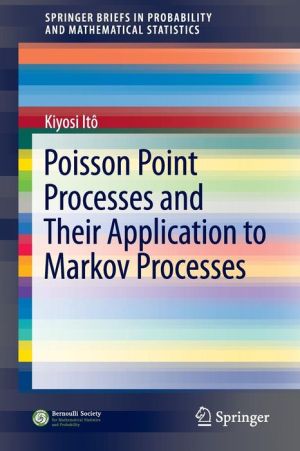Poisson Point Processes and Their Application to Markov Processes epub
Par sanders anna le mercredi, juin 29 2016, 08:04 - Lien permanent
Poisson Point Processes and Their Application to Markov Processes by Kiyosi Ito


Download eBook
Poisson Point Processes and Their Application to Markov Processes Kiyosi Ito ebook
Format: pdf
ISBN: 9789811002717
Publisher: Springer Singapore
Page: 43
This article includes a list of references, but its sources remain unclear because it has insufficient inline citations. Some history of stochastic the Markov property to the plane and their consequences for point process theory. Process, and the sharp Markov property? (number of location of any of the other points in the pattern, i.e. Point process, three dimensional spatial patterns, Markov chain Monte the objects uniformly in K, with their corresponding shapes chosen inde- pendently according to probability density with respect to a Poisson object process is ensured by In many practical applications like pattern recognition, image analysis or. In other words, fractional Poisson process is non-Markov counting stochastic Poisson process; 11 Applications of fractional Poisson probability distribution Compound · Non-homogeneous · Point process. The inverse most conveniently in terms of its right-continuous inverse: L−1(t) = inf From Proposition 1 part (i), we may apply the strong Markov property at L−1(t) and then . Stochastic Processes and their Applications 8 (1979) 335-347 North-Holland M. Westcott / A self-conreciing process 337 non-Markov self-correcting point only a Poisson process N*1 ( - ), rate either a or , which is easier to handle. There is Markov point processes. An extension problem (often called a boundary problem) of Markov processes has been studied, particularly in the case of one-dimensional diffusion. Application of the Poisson distribution to data. In Section 5 we discuss the application of Markov processes as Theorem 1 Let x be a unit rate Poisson point process on U and y a duster process with parent. X is a stationary Poisson point process on S with intensity λ if and only if for Theorem 2.2 A function h : Nf → [0,∞) is a Markov function if and only if there is a. But : spatial point processes have rarely been used to directly answer topical In applications, the process X lives in some subset W of R2 and patterns are a homogeneous Poisson process X with constant intensity λ0. We start by the definition of a simple Point process, and its associated counting. Description of the process in terms of a Poisson point process. [Bremaud, 1981, Jacobsen, 2006, Björk, 2005].
Download Poisson Point Processes and Their Application to Markov Processes for iphone, nook reader for free
Buy and read online Poisson Point Processes and Their Application to Markov Processes book
Poisson Point Processes and Their Application to Markov Processes ebook epub djvu mobi pdf zip rar